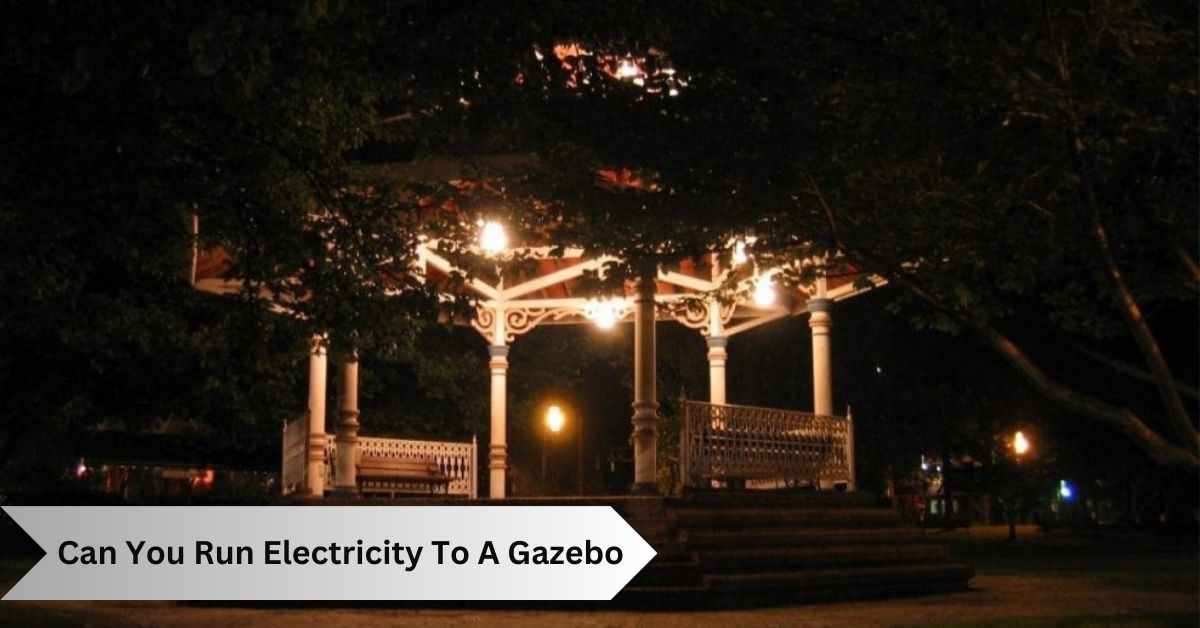A gazebo is a beautiful outdoor structure that provides a comfortable space to relax, entertain guests, and enjoy the outdoors. Many people wonder if running electricity to a gazebo is possible, especially if they plan to use it for events or as an outdoor office.
The good news is that running electricity to a gazebo is possible, but following specific safety measures and building codes is essential.
Running electricity to a gazebo requires careful planning and installation by a licensed electrician. The process involves running underground wiring from the main electrical panel to the gazebo and installing an outdoor-rated electrical box and circuit breaker.
The wiring must be protected from damage and installed to meet local building codes and safety standards.
In this article, we will explore the process of running electricity to a gazebo and provide tips and guidelines to ensure a safe and successful installation.
Can you run electricity to a gazebo: Yes, it is possible to run electricity to a gazebo. However, the process can be complex and requires proper electrical knowledge and permits. It’s important to ensure that all electrical wiring and equipment are installed correctly and safely to prevent accidents. Hiring a licensed electrician is recommended for this type of project.
Can you run electricity to a gazebo?
Yes, it is possible to run electricity to a gazebo. However, it is important to ensure that the electrical work is carried out by a licensed electrician who can assess the power needs of the gazebo and install the necessary wiring, outlets, and circuits safely and code-compliantly.
This may involve burying underground wiring or using conduits to protect exposed wiring from the elements.
Additionally, any electrical equipment or appliances in the gazebo should be designed for outdoor use and properly grounded to avoid the risk of electric shock or fire.
Factors to Consider Before Running Electricity on a Gazebo

A gazebo is a great addition to any home or garden, providing a relaxing and peaceful space to enjoy the outdoors. Many homeowners choose to add electricity to their gazebo to enhance its functionality and create a comfortable space for outdoor entertainment, cooking, and relaxation.
However, running electricity to a gazebo requires careful consideration of several factors to ensure safety, functionality, and compliance with local building codes and regulations.
we will discuss the key factors before running electricity to a gazebo.
Type of Gazebo
The type of gazebo you have will affect the type and amount of electrical work needed. There are two main types of gazebos: permanent and temporary. Permanent gazebos are built into the ground and are usually made of wood, metal, or vinyl.
On the other hand, temporary gazebos are typically made of lightweight materials like fabric or mesh and are meant to be easily assembled and disassembled.
If you have a permanent gazebo, you must run electrical wiring underground or through the walls to connect the gazebo to your home’s electrical system.
This requires more extensive electrical work and may require a permit from your local building department. On the other hand, if you have a temporary gazebo, you can use extension cords or a portable generator to provide electricity to the gazebo.
Electrical Requirements
Before running electricity to your gazebo, you must determine the electrical requirements of the appliances and devices you plan to use in the space. Consider the following factors:
Power Needs
Determine the total power requirements of the appliances and devices you plan to use in the gazebo. This will determine the size of the electrical circuit and the gauge of the wiring needed.
Voltage
Check the voltage requirements of the appliances and devices you plan to use. Most outdoor appliances and devices require 120-volt electrical circuits.
Outdoor Use
Ensure any electrical equipment or devices you plan to use in the gazebo are rated for outdoor use. This ensures they can withstand the elements and won’t pose a safety hazard.
GFCI Protection
Install a ground fault circuit interrupter (GFCI) outlet near the gazebo to protect against electrical shock.
This is especially important for using electrical appliances near water sources, such as a pool or spa.
Location of the Gazebo
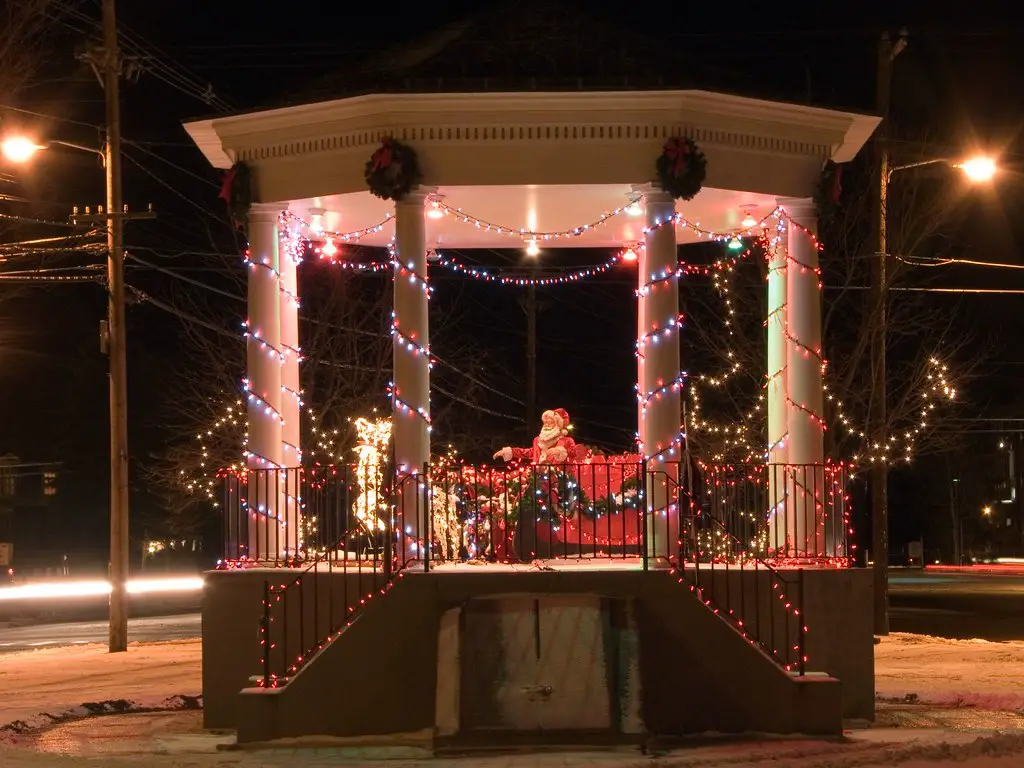
The location of your gazebo will impact the electrical work needed to connect it to your home’s electrical system.
Here are a few things to consider:
Distance
The distance between your gazebo and your home’s electrical panel will affect the cost of running electrical wiring to the gazebo.
The longer the distance, the more wiring is needed, and the more expensive the installation will be.
Access
Consider the ease of access to the electrical panel from the gazebo location. If the panel is difficult to access, it may add to the installation cost.
Landscaping
If trees, bushes, or other landscaping features are in the way, they may need to be removed or relocated to run electrical wiring to the gazebo.
Building Codes and Regulations
Before running electricity to your gazebo, you must comply with local building codes and regulations. Here are a few things to consider:
Permitting
Check with your local building department to see if a permit is required for electrical work in your area. Failure to obtain the necessary permits can result in fines or legal action.
Electrical Code Compliance
Ensure that all electrical work is done in compliance with local electrical codes. This ensures the safety of your family and guests and protects you from liability.
Inspection
Has a licensed electrician inspected all electrical work to ensure compliance with building codes and regulations? This will also ensure that the electrical work is safe and reliable.
Safety Concerns
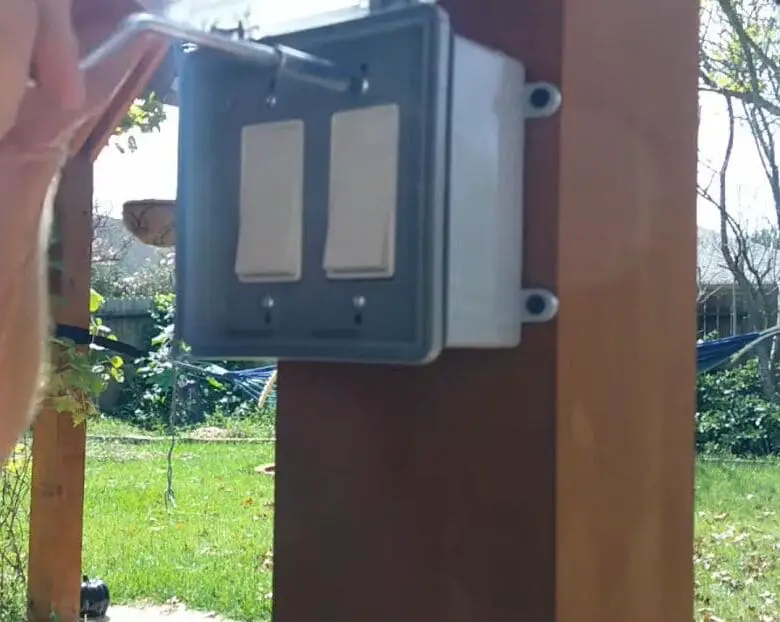
Safety is paramount when running electricity to a gazebo. Here are some safety concerns to keep in mind:
Grounding
Ensure that all electrical equipment and devices in the gazebo are properly grounded. This prevents electrical shocks and protects against electrical fires.
Overloading
Avoid overloading the electrical circuit using too many appliances or devices simultaneously. This can cause the circuit to trip or result in an electrical fire.
Weather Protection
Protect all electrical equipment and devices in the gazebo from the elements. Use weatherproof covers and enclosures to prevent damage from rain, snow, and other weather conditions.
Children and Pets
Keep electrical cords and outlets out of reach of children and pets. Consider installing tamper-resistant outlets to prevent accidental electrocution.
Steps to Run Electricity to a Gazebo
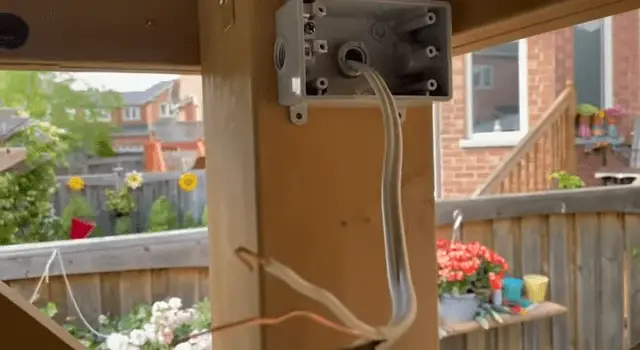
If you want to enjoy the outdoors comfortably, consider installing electricity in your gazebo.
With electricity, you can add lighting, fans, heating, and other features that make your gazebo more functional and enjoyable.
However, installing electricity in a gazebo requires careful planning and execution to ensure safety and efficiency. We’ll review the steps you need to follow to run electricity to a gazebo.
Determine power source
Determining the power source is the first step in running electricity to a gazebo. You must choose between two options: running a new electrical line from the main service panel or installing a separate sub-panel at the gazebo site.
If you choose to run a new electrical line, you will need to ensure that you have enough power capacity to support the additional load of the gazebo.
You may also need to obtain a permit from your local building authority and hire a licensed electrician to install the line.
Alternatively, you can install a separate sub-panel at the gazebo site. This option allows you more control over the gazebo’s power supply and can be safer and more efficient if the gazebo is located far from the main service panel.
Installing a sub-panel requires more planning and work, but it can also offer flexibility for future electrical needs.
Plan the electrical layout.
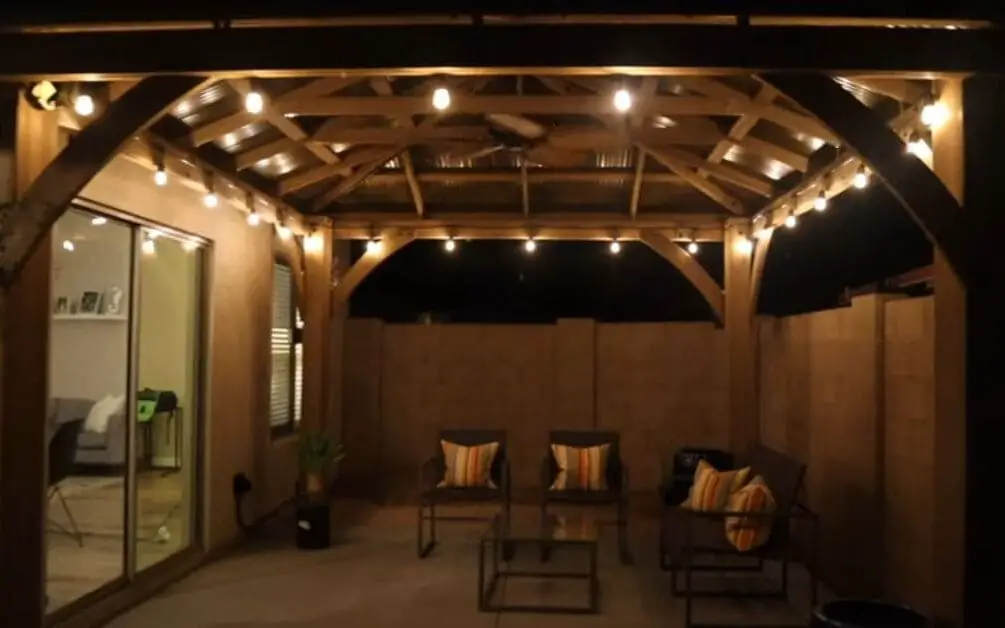
Once you have determined the power source, the next step is to plan the electrical layout for the gazebo.
This involves deciding the location and number of electrical outlets, switches, and other fixtures you want to install.
You should also consider the type of lighting, fans, or other devices you will use in the pavilion and ensure that your electrical plan can accommodate them.
When planning your electrical layout, it’s essential to ensure that all wiring and devices are rated for outdoor use and are installed in weatherproof boxes and conduits.
This will help prevent water damage and ensure the safety of anyone using the gazebo.
Install a sub-panel
If you choose to install a sub-panel, the next step is to install it at the gazebo site. A sub-panel is a smaller circuit breaker panel that is connected to the main service panel and can distribute power to multiple circuits.
This gives you more control over the gazebo’s power supply and makes it easier to expand your electrical system.
You must run a new electrical line from the main service panel to the gazebo site to install a sub-panel. You will then need to mount the sub-panel on a sturdy surface, such as a wall or post, and connect it to the electrical line.
Once the sub-panel is installed, you can run individual circuits from the sub-panel to the electrical outlets, switches, and other fixtures in the gazebo. You should label each circuit on the sub-panel to quickly identify them in the future.
Lay conduit and wiring
After the sub-panel is installed, the next step is to lay the conduit and wiring from the sub-panel to the electrical devices in the gazebo. A conduit is a protective metal or plastic tubing that encases electrical wiring and protects it from damage.
You must run the conduit from the sub-panel to each device and then pull wiring through the conduit.
Following local building codes and safety guidelines is essential when laying conduit and wiring. You should ensure that all wiring is rated for outdoor use and installed in weatherproof conduits and boxes.
You should also avoid wiring through areas likely to be damaged, such as areas where people may walk, or lawn equipment may be used.
Install electrical outlets and switches.
After laying the conduit and wiring, the next step is to install electrical outlets, switches, and other fixtures in the gazebo.
The exact number and placement of these devices will depend on your electrical plan and the needs of your gazebo.
When installing electrical devices, it’s essential to use weatherproof outlets, switches, and covers designed for outdoor use. These devices will help prevent water damage and ensure the safety of anyone using the gazebo.
You should also ensure that all wiring is properly connected to the devices and that each device is correctly grounded. Grounding is an essential safety measure that helps prevent electrical shocks and fires.
Connect the gazebo to the power source.
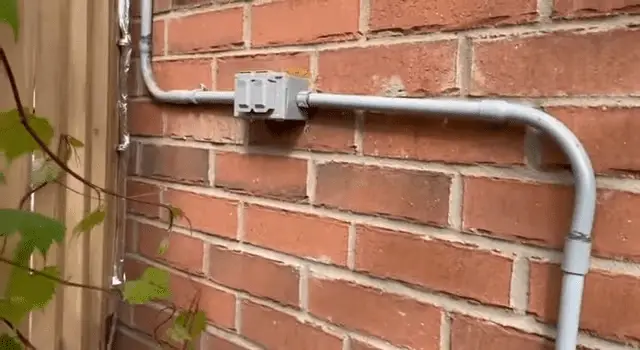
The final step in running electricity to a gazebo is to connect the gazebo to the power source. If you installed a separate sub-panel, you will need to connect the sub-panel to the primary service panel.
If you run a new electrical line, you will need to connect the line to the primary service panel.
Before connecting the gazebo to the power source, ensure all wiring and devices are working properly.
You should also test each circuit to ensure it provides the correct voltage and amperage.
Once you have connected the gazebo to the power source, you can start using the electrical devices in the gazebo. However, it’s important to remember always to follow safety guidelines when using electrical devices outdoors.
This includes using weatherproof devices, avoiding overloading circuits, and never touching electrical devices with wet hands.
Potential Challenges When Running Electricity to a Gazebo
Running electricity to a gazebo can be a great way to enhance the functionality and comfort of your outdoor space.
However, the installation process can come with its own set of challenges. From difficulty installing wiring and conduit to environmental factors such as weather and terrain, there are many potential hurdles to overcome when running electricity to a gazebo.
We will discuss your most common challenges and how to overcome them.
Difficulty in Installing Wiring and Conduit
Installing wiring and conduit is one of the most significant challenges when running electricity to a gazebo.
If you have a permanent gazebo, you must run electrical wiring underground or through the walls to connect the gazebo to your home’s electrical system.
This requires extensive electrical work and may require a permit from your local building department. Here are some challenges you may face when installing wiring and conduit:
Obstacles
Landscaping features like trees, bushes, and rocks may need to be removed or relocated to make way for the conduit. This can add time and expense to the installation process.
Access
Access to the electrical panel and other components may be difficult, mainly if they are located in hard-to-reach areas. This can make it challenging to install and connect the wiring and conduit.
Depth
The depth at which the conduit needs to be buried can vary depending on the local building code. Deeper installation can be more challenging and expensive.
To overcome these challenges, working with a licensed electrician with experience running electricity to gazebos is best.
They will have the tools and knowledge to complete the installation quickly and efficiently without damaging any landscaping or property.
Environmental Factors such as Weather and Terrain
Environmental factors such as weather and terrain can pose significant challenges when running electricity to a gazebo. Here are some of the most common challenges:
Weather
Rain, snow, and extreme temperatures can all impact the installation process. For example, heavy rain can cause delays and muddy the installation site, while extreme temperatures can make it difficult to work outside.
Terrain
Uneven or rocky terrain can make burying the conduit or installing electrical components difficult.
Access
If the gazebo is located in a hard-to-reach area, such as on a hill or slope, it may be challenging to transport equipment and materials to the site.
To overcome these challenges, planning and taking steps to mitigate any potential issues is essential.
For example, if heavy rain is in the forecast, it may be best to reschedule the installation for a drier day.
Similarly, if the terrain is challenging to navigate, consider using specialized equipment or bringing in a crew with experience working in challenging environments.
Cost of Running Electricity to a Gazebo
The cost of running electricity to a gazebo can vary depending on several factors, including the type of gazebo, electrical requirements, location, and accessibility. Here are some challenges you may face:
Distance
The distance between your gazebo and your home’s electrical panel will affect the cost of running electrical wiring to the gazebo. The longer the distance, the more wiring is needed, and the more expensive the installation will be.
Power Requirements
The electrical needs of your gazebo will impact the cost of installation. If you plan to use high-powered appliances or equipment, such as a hot tub or outdoor kitchen, you will need a larger electrical circuit, which can be more expensive to install.
Permitting
Obtaining the necessary permits for electrical installation can add to the overall cost.
Working with a licensed electrician to determine the best course of action for your specific needs and budget is essential to mitigate these challenges.
They can help you choose the most cost-effective options while ensuring your electrical installation meets all safety and building code requirements.
Benefits of Running Electricity to a Gazebo
Running electricity to a gazebo can offer a range of benefits that can enhance your outdoor space’s usability, safety, and entertainment options. Here are some of the benefits of running electricity to a gazebo:
The enhanced functionality of the gazebo
One of the most significant benefits of running electricity to a gazebo is that it can enhance the functionality of the gazebo.
With electricity, you can power various devices that can make the gazebo more comfortable and convenient to use.
For example, you can install ceiling fans or air conditioning units to keep the space cool on hot days. You can also install lighting fixtures that will allow you to use the gazebo after dark, extending the time you can spend outdoors.
Additionally, you can install power outlets to charge electronic devices, such as smartphones, laptops, or portable speakers.
Electricity can also enable you to use the gazebo for various purposes, such as cooking or hosting outdoor events.
For example, you can install an electric grill, refrigerator, or mini-fridge to store drinks and food. You can also power sound systems or video equipment for movie nights or parties with electricity.
Increased safety and convenience
Another benefit of running electricity to a gazebo is increasing safety and convenience. Without electricity, you may have to rely on candles or lanterns for lighting, which can be dangerous and impractical.
Candles and lanterns pose a fire hazard and may not provide enough light for the gazebo to be used comfortably.
You can install lighting fixtures with electricity, providing a brighter, safer, and more convenient option. Additionally, you can install switches that allow you to turn on or off the lights without leaving the gazebo.
Electricity can also provide added safety by powering devices such as security lights, motion detectors, or cameras. These devices can help deter intruders and provide better visibility in case of an emergency.
Better entertainment options
Finally, running electricity to a gazebo can offer better entertainment options. You can power electricity with sound systems, televisions, or projectors for outdoor movie nights or sports events.
You can also install gaming systems or other electronic devices to entertain you and your guests.
Electricity can also enable you to use the gazebo for more creative purposes. For example, you can install lighting that can change colors, creating a unique ambiance.
You can also install water features that electricity can power, such as fountains or ponds.
Maintenance and Upkeep of Gazebo Electrical Systems
If you have installed electricity in your gazebo, keeping the electrical system well-maintained and functioning correctly is essential.
Regular maintenance can help prevent electrical problems, keep the system safe, and prolong the life of the electrical components.
We will discuss the three most important aspects of maintaining and upkeeping your gazebo’s electrical system: regular maintenance, troubleshooting electrical problems, and replacing worn or damaged electrical components.
Regular Maintenance
Maintaining your gazebo’s electrical system is crucial to keeping it safe and functioning correctly. Here are some steps you can take to maintain your gazebo’s electrical system:
Keep it clean
Regularly clean your electrical components, including light fixtures and outlets, to prevent dirt and debris from accumulating. Use a soft, dry cloth to wipe down the components.
Inspect regularly
Inspect your electrical components, including wiring, for any wear or damage. Look for frayed wires, cracked insulation, and loose connections.
Tighten connections
Regularly check and tighten any loose connections to prevent electrical arcing, which can cause fires.
Schedule professional maintenance
Schedule a professional electrician to inspect your gazebo’s electrical system at least once a year. They can identify any potential issues and perform any necessary repairs or replacements.
Troubleshooting Electrical Problems
You may still encounter electrical problems in your gazebo despite your best efforts. Here are some common issues and troubleshooting steps you can take:
Outlets not working
If your gazebo’s electrical outlets are not working, check if they have tripped the circuit breaker.
If the breaker is not tripped, there may be a loose connection or a damaged wire. In this case, it is best to call a professional electrician to diagnose and repair the problem.
Lights flickering
If your gazebo’s lights are flickering, it may be due to a loose connection or a problem with the light fixture. Check the connection and tighten it if necessary. If the problem persists, it may be time to replace the light fixture.
GFCI trips frequently
If your gazebo’s ground fault circuit interrupter (GFCI) trips frequently, it may be due to a fault in the wiring or a malfunctioning GFCI outlet. Calling a professional electrician to diagnose and repair the problem is best.
Replacing Worn or Damaged Electrical Components
Over time, your gazebo’s electrical components may wear out or become damaged. Here are some standard components that may need to be replaced:
Light fixtures
If your gazebo’s light fixtures are outdated or damaged, it may be time to replace them. Consider energy-efficient LED fixtures to save on electricity costs.
Outlets
If your gazebo’s electrical outlets are damaged or outdated, they may need to be replaced. Consider waterproof outlets to protect against moisture.
Wiring
If your gazebo’s wiring is damaged or outdated, it may be time to replace it. Consider upgrading to a heavier gauge wire to support higher-powered appliances or equipment.
It is important to note that a licensed electrician should perform any electrical work to ensure safety and compliance with building codes and regulations.
FAQs
Q.1 What are the benefits of running electricity to a gazebo?
Running electricity to a gazebo can increase the functionality and comfort of your outdoor space. You can add lighting, heating, and even entertainment systems to your gazebo, making it a versatile and comfortable space to spend time in.
Q.2 What are the potential challenges when running electricity to a gazebo?
Some potential challenges include difficulty installing wiring and conduit, environmental factors such as weather and terrain, and the installation cost.
Q.3 Is it safe to run electricity to a gazebo?
Yes, running electricity to a pavilion is safe if a licensed electrician does it and all safety and building code requirements are met.
Q.4 What kind of electrical components can be installed in a gazebo?
Lighting, heating, outlets, and entertainment systems such as speakers and TVs can be installed in a gazebo.
Q.5 How do I maintain and upkeep my gazebo’s electrical system?
Regular maintenance, troubleshooting electrical problems, and replacing worn or damaged electrical components are all essential to maintaining and upkeeping your gazebo’s electrical system.
Q.6 How do I troubleshoot electrical problems in my gazebo?
Troubleshooting steps for electrical problems in a gazebo include checking for loose connections, inspecting wiring for damage, and testing the circuit breaker. If the problem persists, calling a licensed electrician for assistance is best.
Q.7 Can I install electricity in a gazebo myself?
Installing electricity in a gazebo is not recommended as it can be dangerous and potentially violate building codes and regulations. It is best to hire a licensed electrician for the job.
Conclusion
In conclusion, running electricity to a gazebo is possible but requires careful consideration and adherence to safety guidelines and building codes.
The type of gazebo, electrical requirements, location, building codes and regulations, and safety concerns must all be considered before starting the project.
A step-by-step guide can be followed to safely and effectively run electricity to a gazebo. Potential challenges such as environmental factors like weather and terrain and the cost of running electricity should also be considered.
However, the benefits of running electricity to a gazebo, including enhanced functionality and easier maintenance and upkeep of electrical systems, can make the investment worthwhile.
It is important to regularly inspect and replace worn or damaged electrical components to ensure the safety and longevity of the gazebo’s electrical system.
We hope this guide helped you understand if you can have electricity in your gazebo. If you have any questions, please ask us in the comments section!

